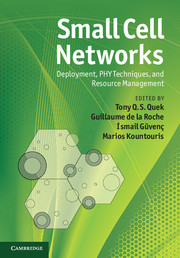Book contents
- Frontmatter
- Contents
- List of contributors
- Foreword by David Chambers
- Acknowledgments
- Acronyms
- 1 Small cell networks overview
- 2 Fundamentals of access control in femtocells
- 3 Coverage analysis using the Poisson point process model
- 4 Interference modeling for cognitive femtocells
- 5 Multiple antenna techniques in small cell networks
- 6 Physical layer techniques for cognitive femtocells
- 7 Femtocell coverage optimization
- 8 Random matrix methods for cooperation in small cell networks
- 9 Mobility in small cell networks
- 10 Cognitive radio resource management in autonomous femtocell networks
- 11 Decentralized reinforcement learning techniques for interference management in heterogeneous networks
- 12 Resource allocation optimization in heterogeneous wireless networks
- 13 New strategies for femto-macro cellular interference control
- 14 Femtocell interference control in standardization
- 15 Spectrum assignment and fairness in femtocell networks
- 16 Self-organization and interference avoidance for LTE femtocells
- Index
- References
7 - Femtocell coverage optimization
Published online by Cambridge University Press: 05 May 2013
- Frontmatter
- Contents
- List of contributors
- Foreword by David Chambers
- Acknowledgments
- Acronyms
- 1 Small cell networks overview
- 2 Fundamentals of access control in femtocells
- 3 Coverage analysis using the Poisson point process model
- 4 Interference modeling for cognitive femtocells
- 5 Multiple antenna techniques in small cell networks
- 6 Physical layer techniques for cognitive femtocells
- 7 Femtocell coverage optimization
- 8 Random matrix methods for cooperation in small cell networks
- 9 Mobility in small cell networks
- 10 Cognitive radio resource management in autonomous femtocell networks
- 11 Decentralized reinforcement learning techniques for interference management in heterogeneous networks
- 12 Resource allocation optimization in heterogeneous wireless networks
- 13 New strategies for femto-macro cellular interference control
- 14 Femtocell interference control in standardization
- 15 Spectrum assignment and fairness in femtocell networks
- 16 Self-organization and interference avoidance for LTE femtocells
- Index
- References
Summary
Introduction
The idea of having a cellular system deployed without planning is quite a challenging one. To have the resulting system work without any human involvement (except for the physical placement of cells) is even more challenging. The motivations for technology to head in this direction are numerous. Among these are the ever-present need to reduce the costs of operating a cellular network, and the need for the cellular network to keep pace with the increasing data demands placed upon it. The concept of a cellular network being able to deploy itself is not new and has been examined philosophically in [1]. The idea of femtocells, or more generally small cells, as a means to fill coverage gaps and to increase capacity is even older. Its roots can be traced back to [2]. There are, however, very good reasons why such deployments have not been successful in the past. The first is that as the size of the cells reduces, in order to increase the spatial frequency reuse, the deployment costs increase (due to the sheer number of additional cells). The second is that, once the cells are deployed, planning such a network manually can be complex and burdensome. If not carefully thought through, any insertion of a new cell into the topology can have detrimental rather than beneficial effects. These simple facts may often ruin the business case for the deployment of additional cells.
- Type
- Chapter
- Information
- Small Cell NetworksDeployment, PHY Techniques, and Resource Management, pp. 161 - 187Publisher: Cambridge University PressPrint publication year: 2013



